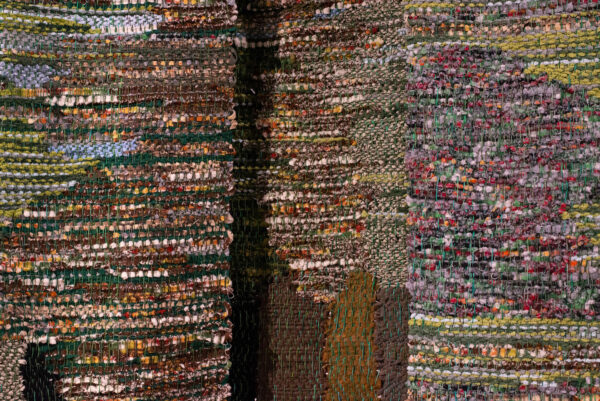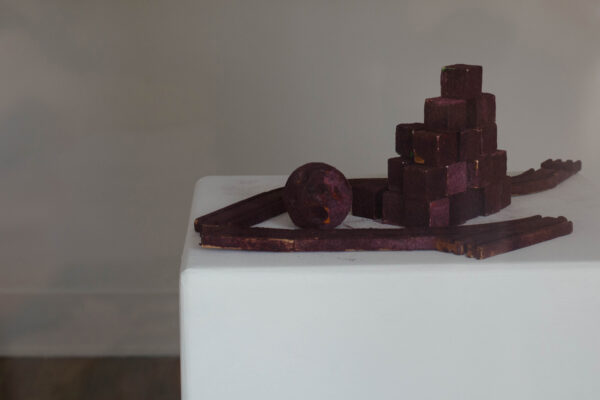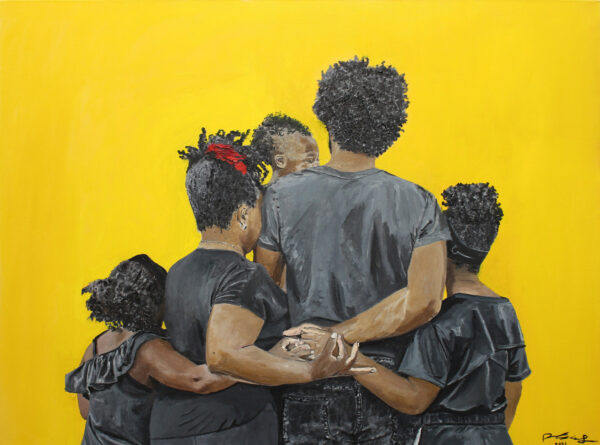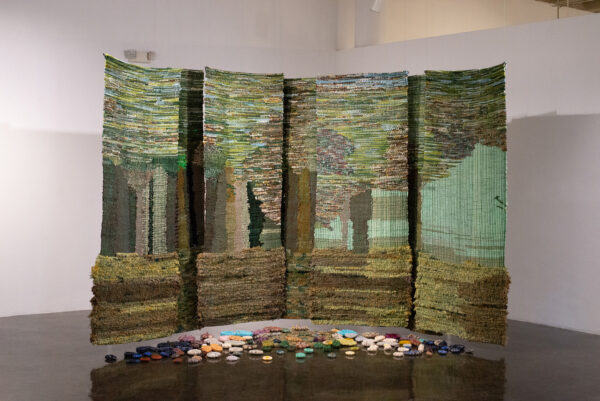In addition to heralding spring, regrowth, and transformation, the month of March also brings Contemporary Art Month (CAM) to San Antonio. The annual event is full of ample opportunities to experience local art and celebrate both emerging and established artists. This year’s 2022 CAM Perennial exhibition, Interior Realities, is curated by Lauren Cross, Ph.D, and is on display at two collaborating locations: Sala Diaz and the Southwest School of Art.
Work from 17 artists is on view, exploring and linking the diverse and joint experiences that shape life for artists living and working in the city. Unable to separate life as we know it from the COVID-19 pandemic and other recent global events, the exhibition tackles themes of internal and external struggles that emerge with our ever-evolving reality.
Nestled in the Southwest School of Art’s Santikos Building is the work of Juan Escobedo, Anthony Francis, Gabe Garcia, Carly Garza, Gabi Magaly, Bárbara Miñarro, Patty Ortiz, Alán Serna, Julysa Sosa, Alannah Tiller, Doerte Weber, and Guillermina Zabala. Lofty, open, and accommodating, the space is fitting for artworks that explore shared threads of experience. In her curatorial statement, Cross explains that the Southwest School of Art speaks to “the ways in which personal identity, borders, and land relationships illuminate the realities of oppression or the ways in which suppressed realities enact agency, expression, and reclamation as a source of survival and empowerment.”
Commanding an immediate presence in this space is Doerte Weber’s 2022 woven fiber installation, Part of Nature. The woven panel portions of the work seem to levitate in the air, hung by thin threads attached to the coffered ceiling above. Below, disk-shaped pebbles wrapped in multicolored yarn rest on the ground. The levitating panels line up to resemble a wooded landscape, created in shades of green and brown material.
According to Weber’s artist statement, situated on the wall behind her installation, the work is composed of 80% recycled and repurposed materials. The Studio Manager at the Southwest School of Art, Blake Kennedy, pointed out how the panels move and sway in the breeze of the air conditioning, simulating the rustling of trees in the wind. With Weber’s reflection on the natural environment, combined with materials sourced from leftover waste (mainly in the form of slowly decomposing plastic material), the artist transforms the once romanticized notions of nature into an image more compatible with current environmental circumstances.

Doerte Weber, “Part of Nature” (detail), 2022, woven fiber installation. Photograph by Ashley Allen.
Similarly undermining traditional modes of representation, and what I found to be somewhat reminiscent of Cubist collages, is Shipping Migrant #3. The collage work, created in 2022 by artist and curator Patty Ortiz, depicts a deconstructed white shipping box that is covered with two shipping labels and fragments of what appear to be maps collaged onto its flat surface. Creating a formal tension, the three-dimensional box is made flat in a mesh of straight lines, planes, and partial volumes of varying sizes, shapes and colors.
The fragmented use of text, especially in the partial lettering that looks like a folded-over sticker referencing the word “fragile,” adds another level of manipulation, and a feeling of being torn apart begins to emerge. Ironically, the box itself — what was once a secure vessel for the fragile contents within — is splayed apart and put on display in a discombobulated manner caused by mishandling. The piece’s title, Shipping Migrant #3, gives a linguistic clue to the signified context; perhaps the work can be seen as a powerful comment on the potentially scarring and impactful realities of transferences, such as immigration and migration.

Patty Ortiz, “Shipping Migrant #3,” 2022, collage, charcoal, graphite, oil stick on paper. Photograph by Ashley Allen.
Down the street, at Sala Diaz, lies the partnering portion of the CAM Perennial exhibition, featuring the work of Raul Rene Gonzalez, Sara Corley Martinez, Jacqueline Saragoza McGilvray, Martín C. Rodríguez, and Hanna Hurricane Sanchez. A smaller space, Sala Diaz is fitting for the more intimate narratives explored in these artists’ personal work.
One of the first pieces that caught my attention is a 2021 sculpture created by Sara Corley Martinez titled Plum Dust Objects. The work involves an assemblage of children’s toys, train tracks, building blocks, and two balls, all of which are flocked in a purplish-maroon dust. In her work, Martinez explores themes of motherhood, control, and the varied experiences brought on by having a child.

Sara Corley Martinez, “Plum Dust Objects,” 2021, children’s toys and flocking. Photograph by Ashley Allen.
Looking at Plum Dust Objects, I experienced an overwhelming urge to touch, and to sweep away the overflow of purple dust settled on the white pedestal the sculpture stands on. As alluded to by this mysterious purple dust, the work helped me see how a mother might feel a similar urge to keep her kids’ toys sanitary, especially after widespread fears of invisible particles sparked by COVID-19. In this way, Martinez aesthetically transforms the invisible and floating into a clear marker of potential danger or uncleanliness.
Hanging on the wall opposite of Martinez’ Plum Dust Objects is the vibrantly colored work of Raul Rene Gonzalez, a multimedia artist whose personal work explores fatherhood, identity, and socially maintained roles and stereotypes. Three of Gonzalez’s paintings are on display, all depicting different (but similarly intimate) scenes of artists and their families.
One features artist Amber Ortega and her children, while in another painting, Julia Barbosa Landois is depicted multitasking in the studio with her children. It is interesting to note that these pieces are Gonzalez’ first experience with oil painting, which is hard to believe considering the painterly aspects of the work.

Raul Rene Gonzalez, “Photographer Anthony Francis and Family,” 2021. Photograph courtesy of Lauren Cross.
However, the painting dripping with the most vibrancy and emotion for me was Gonzalez’ portrait of Anthony Francis and his family. Something about the vibrant yellow color of the background of this piece works to stand out and create space for itself. The touching family portrait depicts Francis’ family from behind, allowing Gonzalez to depict the five family members all entwined together: linked with arms, hands, and bodies.
This gesture, a symbol of togetherness, evokes the feeling that Francis’ family is linked by something metaphorical, something that goes beyond the surface of the paint. Quite emotionally apparent, the family bond lingers through the space. The unity speaks poignantly to shared struggles and to the power of love that is family.
Seen in unison, the CAM 2022 Perennial exhibition at the Southwest School of Art and Sala Diaz invites visitors to contemplate both the shared and intimate realities of what it is like living and working in San Antonio during times of major global events. The work offers much to meditate on, acting as a kind of respite and reflection after the past few tumultuous years. The show is on-view at the Southwest School of Art until April 6, and will close on April 20 at Sala Diaz.
****
Ashley Allen is an artist and writer living and working in San Antonio. She is the recipient of the inaugural Fellowship for Critical Writing for Contemporary Art Month (CAM) San Antonio. This is the third of four texts she will be contributing to Glasstire throughout the month of March 2022.



